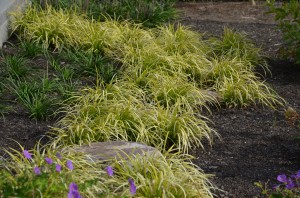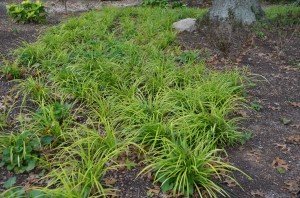If you live in the Southeastern U.S., another variety of liriope probably will not impress you. Here we call it “monkeygrass”. PeeDee Ingot liriope (Liriope muscari ‘PeeDee Ingot’) is no ordinary ground cover (USDA hardiness zones 6-10). ‘Peedee Ingot’ liriope is named after the Peedee River in South Carolina near where it was found.
You might mistake it for Ogon sweetflag (Acorus gramineus ‘Ogon’) for its gold colored foliage. Liriope’s lilac-lavender flower spikes in mid-summer should convince you otherwise. Individual clumps grow a bit more than 18 inches tall and almost twice that in width.
The spikes of lilac-lavender flower provides a wide contrast against the grass-like chartreuse leaf blades. Plant it in average well-drained soils and in partial to full sun for best expression of its gold color. PeeDee Ingot needs some respite in summers south of zone 7. Its gold color will likely fade away or burn leaf tips if sunlight is too bright and the ground too dry.
Annual growth rate is not as rapid as many green leaf liriopes. This long-lived perennial is easy to grow with few disease and pest problems. PeeDee Ingot tolerates heavy shade, but most of its golden hue fades away by late summer. Clumps can be dug and divided almost any time they’re actively growing.
PeeDee Ingot is commonly used as a ground cover, utilized for front bed edging in the garden or container. It serves as a beautiful foil among other nearby plants with green or purple foliage colors.
Like most liriopes, the evergreen foliage maintains its presence through the winter, although abit bedraggled by winter’s end. Now is the time for a drastic crew cut to freshen foliage that will be emerging shortly. Pruning (mowing down) clumps is done at the start of spring.



 Posted in
Posted in 
